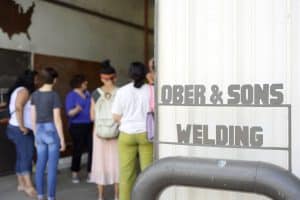PROJECT FREEWAY: AN INTRO TO ALIEF
The DiverseWorks team kicked off Project Freeway on June 13th, with a group field trip to Southwest Houston–Alief, Texas, the team’s home away from home for the next few weeks. Here we’ll explore, meet, and get to know the diverse communities that co-exist within the loose geographic boundaries of Beltway 8, US 59, Westpark Tollway, and Eldridge.
Our introductory visit revealed to us that Alief is home to clusters of cultural identities and ethnically diverse neighborhoods. As you enter the area, you’re immediately greeted by street signs that orient you in three languages, English, Vietnamese, and Chinese. Towards the center of town lies a community library that holds a plethora of books and resources in various languages, allowing children and the elderly to read side by side. In addition to the different languages highlighted across town, as we drove down Bellaire and Beechnut we were awed by the enormous variety of culturally specific restaurants.

Hot and sticky most days, these trips have been met with welcoming arms and provided great insight. Through our fieldwork so far, we’ve recognized similarities to the larger geographic and cultural issues often found in Houston’s art communities. The neighborhoods and the people who live here offer a breadth of generational backgrounds, interests, and cultures. Whether it be language barriers, the shape of neighborhood lines, or predisposed cultural perceptions, we are becoming aware of how easily divisions can take shape and form siloed sub-communities.
Through this project, we’ve been pushing ourselves to think non-traditionally about the word art and the idea of space. In Alief, we hope by continuing our visits and better educating ourselves on the values and traditions hidden in this community that we continue to open our definitions and practices, while at the same time finding ways to encourage connections and community collaboration.
As we prepare for our next visit, we’ll meet individual artists from different disciplines, who have a history with Alief through their work or family in order to begin deepening our connections in the area.
photos by Ronald Jones
